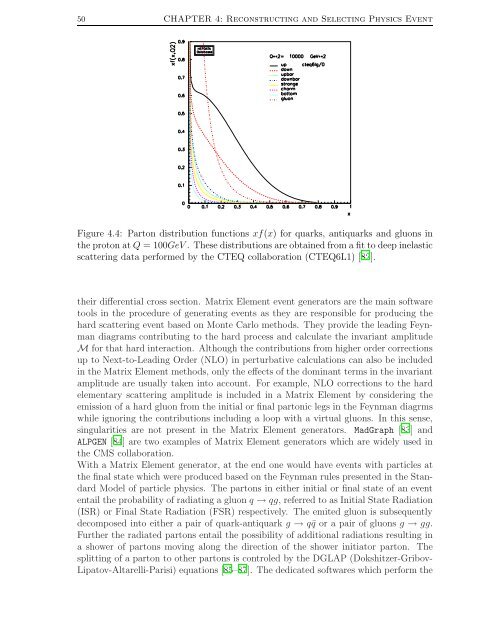Measurement of the Jet Energy Scale in the CMS experiment ... - IIHE
Measurement of the Jet Energy Scale in the CMS experiment ... - IIHE
Measurement of the Jet Energy Scale in the CMS experiment ... - IIHE
You also want an ePaper? Increase the reach of your titles
YUMPU automatically turns print PDFs into web optimized ePapers that Google loves.
50 CHAPTER 4: Reconstruct<strong>in</strong>g and Select<strong>in</strong>g Physics EventFigure 4.4: Parton distribution functions xf(x) for quarks, antiquarks and gluons <strong>in</strong><strong>the</strong> proton at Q = 100GeV . These distributions are obta<strong>in</strong>ed from a fit to deep <strong>in</strong>elasticscatter<strong>in</strong>g data performed by <strong>the</strong> CTEQ collaboration (CTEQ6L1) [82].<strong>the</strong>ir differential cross section. Matrix Element event generators are <strong>the</strong> ma<strong>in</strong> s<strong>of</strong>twaretools <strong>in</strong> <strong>the</strong> procedure <strong>of</strong> generat<strong>in</strong>g events as <strong>the</strong>y are responsible for produc<strong>in</strong>g <strong>the</strong>hard scatter<strong>in</strong>g event based on Monte Carlo methods. They provide <strong>the</strong> lead<strong>in</strong>g Feynmandiagrams contribut<strong>in</strong>g to <strong>the</strong> hard process and calculate <strong>the</strong> <strong>in</strong>variant amplitudeM for that hard <strong>in</strong>teraction. Although <strong>the</strong> contributions from higher order correctionsup to Next-to-Lead<strong>in</strong>g Order (NLO) <strong>in</strong> perturbative calculations can also be <strong>in</strong>cluded<strong>in</strong> <strong>the</strong> Matrix Element methods, only <strong>the</strong> effects <strong>of</strong> <strong>the</strong> dom<strong>in</strong>ant terms <strong>in</strong> <strong>the</strong> <strong>in</strong>variantamplitude are usually taken <strong>in</strong>to account. For example, NLO corrections to <strong>the</strong> hardelementary scatter<strong>in</strong>g amplitude is <strong>in</strong>cluded <strong>in</strong> a Matrix Element by consider<strong>in</strong>g <strong>the</strong>emission <strong>of</strong> a hard gluon from <strong>the</strong> <strong>in</strong>itial or f<strong>in</strong>al partonic legs <strong>in</strong> <strong>the</strong> Feynman diagrmswhile ignor<strong>in</strong>g <strong>the</strong> contributions <strong>in</strong>clud<strong>in</strong>g a loop with a virtual gluons. In this sense,s<strong>in</strong>gularities are not present <strong>in</strong> <strong>the</strong> Matrix Element generators. MadGraph [83] andALPGEN [84] are two examples <strong>of</strong> Matrix Element generators which are widely used <strong>in</strong><strong>the</strong> <strong>CMS</strong> collaboration.With a Matrix Element generator, at <strong>the</strong> end one would have events with particles at<strong>the</strong> f<strong>in</strong>al state which were produced based on <strong>the</strong> Feynman rules presented <strong>in</strong> <strong>the</strong> StandardModel <strong>of</strong> particle physics. The partons <strong>in</strong> ei<strong>the</strong>r <strong>in</strong>itial or f<strong>in</strong>al state <strong>of</strong> an evententail <strong>the</strong> probability <strong>of</strong> radiat<strong>in</strong>g a gluon q → qg, referred to as Initial State Radiation(ISR) or F<strong>in</strong>al State Radiation (FSR) respectively. The emited gluon is subsequentlydecomposed <strong>in</strong>to ei<strong>the</strong>r a pair <strong>of</strong> quark-antiquark g → q¯q or a pair <strong>of</strong> gluons g → gg.Fur<strong>the</strong>r <strong>the</strong> radiated partons entail <strong>the</strong> possibility <strong>of</strong> additional radiations result<strong>in</strong>g <strong>in</strong>a shower <strong>of</strong> partons mov<strong>in</strong>g along <strong>the</strong> direction <strong>of</strong> <strong>the</strong> shower <strong>in</strong>itiator parton. Thesplitt<strong>in</strong>g <strong>of</strong> a parton to o<strong>the</strong>r partons is controled by <strong>the</strong> DGLAP (Dokshitzer-Gribov-Lipatov-Altarelli-Parisi) equations [85–87]. The dedicated s<strong>of</strong>twares which perform <strong>the</strong>
















